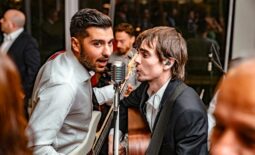How Your Musical Vision is like Your Accent
Do you think you have an accent? Probably not. You are so used to the way you and the people around you speak, that you don’t think you do. It’s people from the Midwest / the East Coast / Spain / Brazil / Africa / you name it that have the accent.
Check out this amazing video of Amy Walker doing 21 accents in two minutes.
When her Seattle accent came up, I thought, wait, that one’s not an accent, that’s just “normal” speaking! But of course that’s just because her Seattle accent is the closest one to my own. To you, the Seattle accent may actually sound like an accent.
…
I’m not writing about diction or enunciation today. I’m actually writing about finding your vision.
Your accent is a metaphor for your vision of your live show.
In the same way that it’s not easy to describe or identify your own accent, it’s not easy to describe your musical vision. It’s too close, it’s too familiar. You can’t even see or hear it. But you probably do have a vision, just as you have an accent. If you can’t find it, you can finally start to see it when you compare it to other visions (or accents).
So get on YouTube and start watching live videos. Go to some concerts – of artists both in your genre and outside your genre. Pay attention to all of the elements. Start to see what you take for granted. And make notes, tons of notes – both on what belongs in your show and what definitely does not.
Here are some things to notice: How many musicians are on stage? What is the lineup? How many of them sing? What are they wearing? What are their ages? Are there lights or media? Video? Decorations on stage? A backdrop? Are people sitting and listening politely, or are they rowdy, dancing, partying? What is the atmosphere in the room, how does everyone feel? How big is the audience? What does the audience look like? How big is the stage? Is it indoors or outdoors? What genre of music are you playing? Is it largely improvisational or is it mostly fixed in structure? Is it instrumentally or vocally focused? Is anyone wearing costumes? Are you in ripped clothing, a cocktail dress, a Bjork or Gaga getup? What is the energy level? Do you have dancers on stage? Do you have backup singers? Are you playing an instrument? Do you have guest musicians who step in? Is it a community-oriented performance where the audience participates musically or otherwise, or is it a classical or jazz performance in a theatre with tiered seats? What type of venue is it – an arena, a restaurant, an outdoor festival, a wedding, a coffee shop, a house concert, a backyard, a flatbed trailer?
This is only the beginning. These questions help you just start to work with the basics. But once you have your basic vision down, you have a framework to think within and make decisions within. You have a place to start with, to add your own unique elements you haven’t seen anywhere else.
Creativity thrives within a framework, so even if you don’t have a complete vision yet, start its framework!



